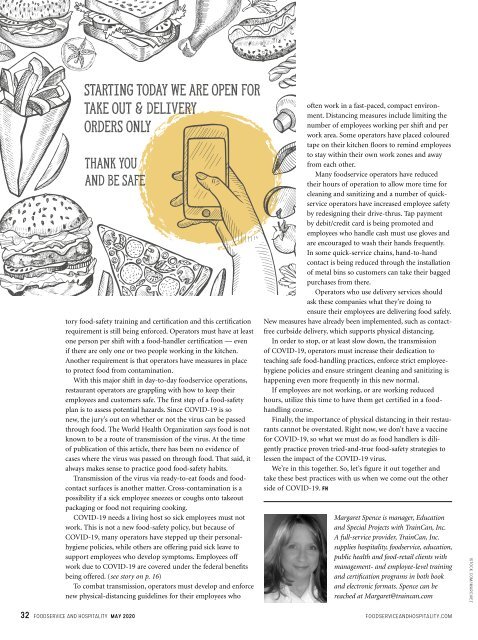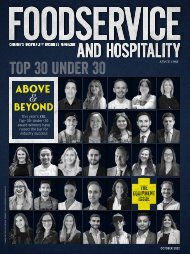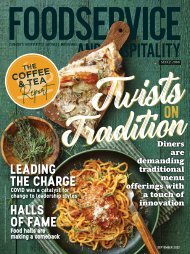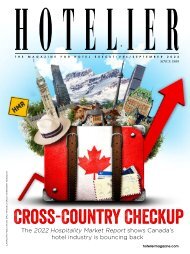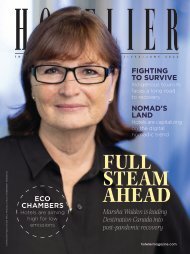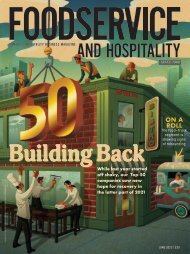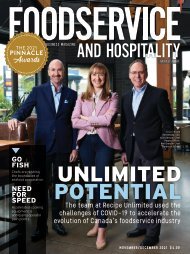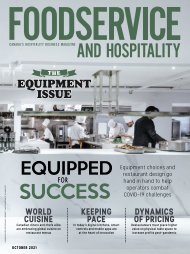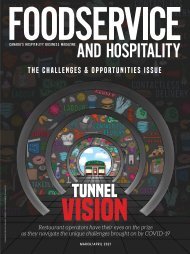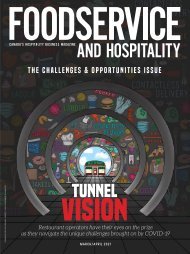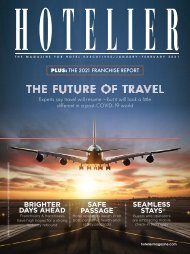May 2020
May 2020 issue of Foodservice and Hospitality magazine.
May 2020 issue of Foodservice and Hospitality magazine.
Create successful ePaper yourself
Turn your PDF publications into a flip-book with our unique Google optimized e-Paper software.
tory food-safety training and certification and this certification<br />
requirement is still being enforced. Operators must have at least<br />
one person per shift with a food-handler certification — even<br />
if there are only one or two people working in the kitchen.<br />
Another requirement is that operators have measures in place<br />
to protect food from contamination.<br />
With this major shift in day-to-day foodservice operations,<br />
restaurant operators are grappling with how to keep their<br />
employees and customers safe. The first step of a food-safety<br />
plan is to assess potential hazards. Since COVID-19 is so<br />
new, the jury’s out on whether or not the virus can be passed<br />
through food. The World Health Organization says food is not<br />
known to be a route of transmission of the virus. At the time<br />
of publication of this article, there has been no evidence of<br />
cases where the virus was passed on through food. That said, it<br />
always makes sense to practice good food-safety habits.<br />
Transmission of the virus via ready-to-eat foods and foodcontact<br />
surfaces is another matter. Cross-contamination is a<br />
possibility if a sick employee sneezes or coughs onto takeout<br />
packaging or food not requiring cooking.<br />
COVID-19 needs a living host so sick employees must not<br />
work. This is not a new food-safety policy, but because of<br />
COVID-19, many operators have stepped up their personalhygiene<br />
policies, while others are offering paid sick leave to<br />
support employees who develop symptoms. Employees off<br />
work due to COVID-19 are covered under the federal benefits<br />
being offered. (see story on p. 16)<br />
To combat transmission, operators must develop and enforce<br />
new physical-distancing guidelines for their employees who<br />
often work in a fast-paced, compact environment.<br />
Distancing measures include limiting the<br />
number of employees working per shift and per<br />
work area. Some operators have placed coloured<br />
tape on their kitchen floors to remind employees<br />
to stay within their own work zones and away<br />
from each other.<br />
Many foodservice operators have reduced<br />
their hours of operation to allow more time for<br />
cleaning and sanitizing and a number of quickservice<br />
operators have increased employee safety<br />
by redesigning their drive-thrus. Tap payment<br />
by debit/credit card is being promoted and<br />
employees who handle cash must use gloves and<br />
are encouraged to wash their hands frequently.<br />
In some quick-service chains, hand-to-hand<br />
contact is being reduced through the installation<br />
of metal bins so customers can take their bagged<br />
purchases from there.<br />
Operators who use delivery services should<br />
ask these companies what they’re doing to<br />
ensure their employees are delivering food safely.<br />
New measures have already been implemented, such as contactfree<br />
curbside delivery, which supports physical distancing.<br />
In order to stop, or at least slow down, the transmission<br />
of COVID-19, operators must increase their dedication to<br />
teaching safe food-handling practices, enforce strict employeehygiene<br />
policies and ensure stringent cleaning and sanitizing is<br />
happening even more frequently in this new normal.<br />
If employees are not working, or are working reduced<br />
hours, utilize this time to have them get certified in a foodhandling<br />
course.<br />
Finally, the importance of physical distancing in their restaurants<br />
cannot be overstated. Right now, we don’t have a vaccine<br />
for COVID-19, so what we must do as food handlers is diligently<br />
practice proven tried-and-true food-safety strategies to<br />
lessen the impact of the COVID-19 virus.<br />
We’re in this together. So, let’s figure it out together and<br />
take these best practices with us when we come out the other<br />
side of COVID-19. FH<br />
Margaret Spence is manager, Education<br />
and Special Projects with TrainCan, Inc.<br />
A full-service provider, TrainCan, Inc.<br />
supplies hospitality, foodservice, education,<br />
public health and food-retail clients with<br />
management- and employee-level training<br />
and certification programs in both book<br />
and electronic formats. Spence can be<br />
reached at Margaret@traincan.com<br />
ISTOCK.COM/MARCHIEZ<br />
32 FOODSERVICE AND HOSPITALITY MAY <strong>2020</strong> FOODSERVICEANDHOSPITALITY.COM


